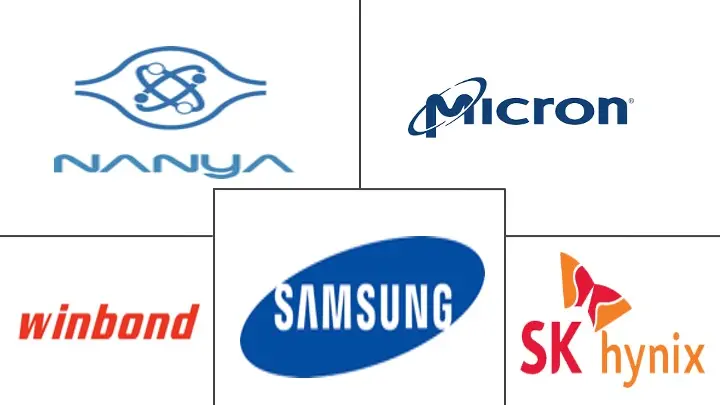Dynamic Random Access Memory (DRAM) Market Size and Share
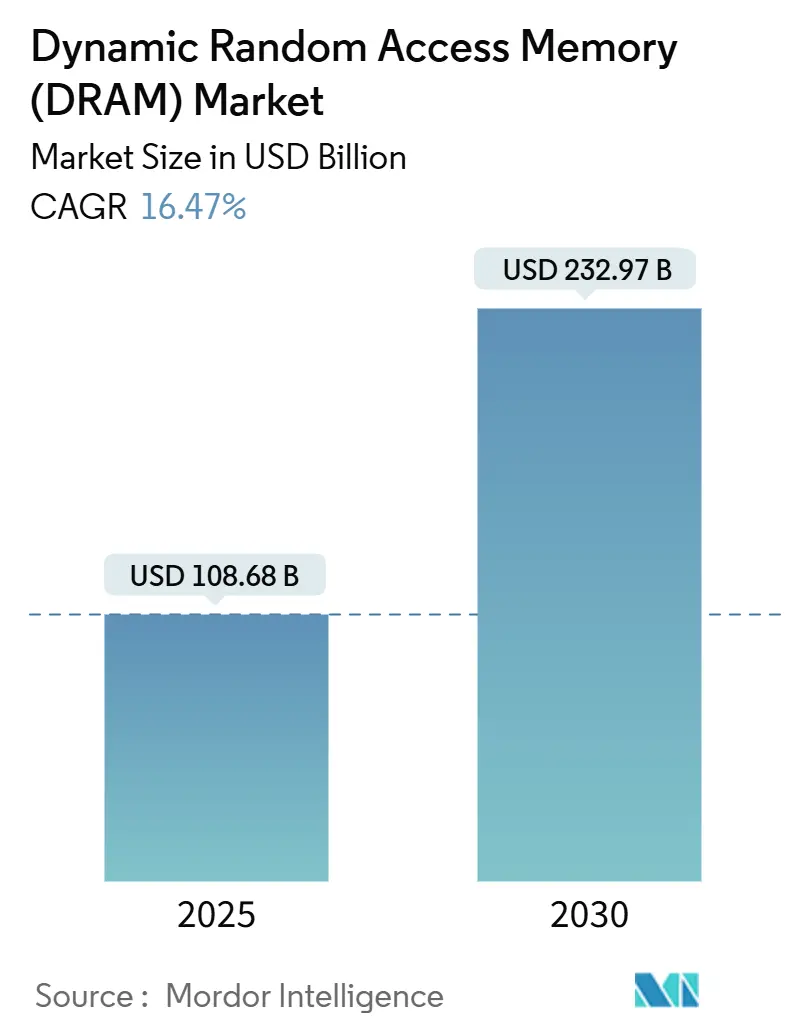
Dynamic Random Access Memory (DRAM) Market Analysis by Mordor Intelligence
The Dynamic Random Access Memory market size is valued at USD 108.68 billion in 2025 and is projected to reach USD 232.97 billion by 2030, translating into a strong 16.47% CAGR. Accelerated adoption of AI-centric servers, the steep ramp-up of high-bandwidth memory, and tighter automotive qualification requirements have shifted purchasing criteria from capacity alone to a balanced focus on bandwidth, power, and thermal performance. Hyperscale cloud operators began refreshing racks with DDR5 and HBM3E modules during 2024, while handset OEMs in Asia moved much of their flagship and mid-tier portfolios to LPDDR5X, collectively keeping fab utilization above 95% through mid-2025. Memory content per electric vehicle rose quickly as zonal architectures replaced traditional ECU networks, pushing automotive DRAM demand into multi-gigabyte territory. At the same time, supply allocation conflicts between lucrative HBM3E and legacy DDR4 lines triggered price surges that reshaped cost-performance trade-offs for PCs, smartphones, and industrial IoT boards.
Key Report Takeaways
- By architecture, DDR4 held a 45.3% Dynamic Random Access Memory market share in 2024, whereas DDR5 is forecast to expand at a 30.2% CAGR to 2030.
- By technology node, the 19 nm–10 nm category captured 42.3% of the Dynamic Random Access Memory market size in 2024 and is advancing at a 25.2% CAGR through 2030.
- By capacity, 4–8 GB modules commanded 41.3% of the Dynamic Random Access Memory market size in 2024, while ≥16 GB configurations are set to grow at 28.2% between 2025 and 2030.
- By end-use application, smartphones and tablets led with 35.2% revenue share in 2024; automotive electronics is projected to climb at a 31.2% CAGR through 2030.
- By geography, Asia-Pacific accounted for 31.2% of 2024 sales, whereas South America is expected to post a 22.2% CAGR over the forecast window.
Global Dynamic Random Access Memory (DRAM) Market Trends and Insights
Drivers Impact Analysis
| Driver | (~) % Impact on CAGR Forecast | Geographic Relevance | Impact Timeline |
|---|---|---|---|
| Ascending Content Footprint of AI and Generative-AI Workloads in Hyperscale Data Centers | +4.2% | Global, with concentration in North America and APAC | Medium term (2-4 years) |
| Soaring LPDDR Adoption in 5G Flagship and Mid-Tier Smartphones Across APAC | +3.8% | APAC core, spill-over to global markets | Short term (≤ 2 years) |
| Automotive Zonal/Domain Controllers Migrating from NOR to High-Temperature DRAM | +2.9% | Global, early adoption in Europe and North America | Long term (≥ 4 years) |
| Edge-AI and Industrial IoT Boards Requiring Extended-Temperature DRAM Modules | +2.1% | Global, with manufacturing hubs in APAC | Medium term (2-4 years) |
| Cloud Service Providers' Transition to CXL-attached Memory Pools | +1.8% | North America and EU, expanding to APAC | Long term (≥ 4 years) |
| Source: Mordor Intelligence | |||
Ascending content footprint of AI and generative-AI workloads in hyperscale data centers
NVIDIA’s 2025 Blackwell GP-AI platforms established bandwidth baselines that eclipsed conventional DDR architectures, lifting average server memory from 256 GB in 2024 to multi-terabyte deployments by mid-2025. With each HBM3E stack delivering more than 1 TB/s, cloud operators re-architected racks around memory-centric topologies. Samsung delivered production-ready CXL 2.0 DRAM that allowed Azure and other providers to pool memory across hosts, improving utilization while deferring capex on additional compute nodes.[1]Samsung Electronics, “CXL DRAM Enables New Data-Center Memory Architecture,” semiconductor.samsung.com Suppliers consequently shifted wafer starts from DDR4 to HBM, triggering tightness in legacy grades but accelerating profit growth in the premium segment.
Soaring LPDDR adoption in 5G flagship and mid-tier smartphones across APAC
Micron’s 1γ LPDDR5X samples running at 9,200 MT/s reached handset makers in Q1 2025, cutting power by 20% and raising baseline configurations in Chinese and Indian models from 8 GB to 12 GB RAM. Xiaomi, OPPO, and emerging brands such as Transsion are locked in forward contracts that consume a growing slice of APAC fab capacity, forcing suppliers to juggle commitments between mobile and datacenter lines. The shift gave LPDDR a steeper growth curve than any other mobile memory since LPDDR4 entered mass production in 2015.
Automotive zonal and domain controllers migrating from NOR to high-temperature DRAM
Electric vehicles built on software-defined platforms required memory pools that dwarfed legacy infotainment footprints. Several European OEMs validated 16 GB AEC-Q100-qualified DRAM in 2024 and subsequently raised platform targets toward 90 GB per vehicle in 2025 schedules. Samsung and SK Hynix invested in wide-temperature process tweaks to secure ISO 26262 conformity, creating barriers for new entrants and improving price discipline in the automotive grade corner of the Dynamic Random Access Memory market.
Edge-AI and industrial IoT boards requiring extended-temperature DRAM modules
Factory automation suppliers upgraded programmable logic controllers and vision systems with DDR4-3200 at –40 °C to 85 °C ratings, enabling local AI inference that cuts cloud round-trip latency. ATP and Innodisk capitalized on the niche by offering conformal-coated DIMMs with aggressive refresh management, which industrial OEMs accepted at 30% premiums over commercial-grade parts. The resulting margin uplift incentivized DRAM majors to license ruggedization processes, expanding supply through 2026.
Restraints Impact Analysis
| Restraint | (~) % Impact on CAGR Forecast | Geographic Relevance | Impact Timeline |
|---|---|---|---|
| Supply–Demand Cyclicality Driving Extreme ASP Volatility | -2.8% | Global, with amplified effects in spot markets | Short term (≤ 2 years) |
| Yield-Erosion Challenges Below 10 nm EUV Nodes | -1.9% | Global, concentrated in advanced fabs | Medium term (2-4 years) |
| Geopolitical Export Controls on China Limiting High-density Server DRAM Shipments | -1.4% | China-focused, with global supply chain impacts | Long term (≥ 4 years) |
| Source: Mordor Intelligence | |||
Supply–demand cyclicality driving extreme ASP volatility
High-margin HBM pull-ins persuaded fabs to postpone DDR4 runs early in 2025, igniting a 50% spot-price jump for mainstream modules in May. DDR5 contracts also climbed 15–20%, prompting OEMs to re-engineer product bills of materials or over-order to hedge against further spikes. The feedback loop amplified volatility and cut visibility for production planning, knocking two-plus points from the Dynamic Random Access Memory market’s forecast CAGR.
Yield-erosion challenges below 10 nm EUV nodes
Early runs of 1β and 1γ nodes suffered mask defectivity and stochastic line edge roughness, dragging yields into the low 70% range at some fabs. Samsung and Micron allocated sizeable R&D budgets to resist improvements and new pellicle technology, yet learning curves lengthened ramp timelines. Tight yields curtailed die output during a window of peak demand, adding cost pressure that cascaded across consumer and enterprise segments.[2]TrendForce, “Samsung Targets 1c DRAM Yield Improvement by Mid-2025,” trendforce.com
Segment Analysis
By Architecture: DDR5 Acceleration Reshapes Memory Hierarchies
DDR5 accounted for a minimal share of the Dynamic Random Access Memory market in 2024, yet carried the fastest 30.2% forecast CAGR, underpinned by JEDEC’s JESD79-5C update that lifted performance ceilings to 8,800 Mbps. That technical leap allowed tier-1 cloud builders to run mixed DDR5-HBM3E configurations that doubled per-socket effective bandwidth. Micron’s 1γ DDR5 reached 9,200 MT/s in February 2025, a milestone that pushed server OEMs to pull forward platform refreshes. Meanwhile, DDR4 retained a 45.3% Dynamic Random Access Memory market share through 2024 because corporate IT budgets still favoured cost-optimized configurations. Legacy DDR3 and DDR2 footprints continued to shrink as industrial and automotive design-ins migrated to newer standards.
Suppliers confronted a balancing act: every wafer reassigned to DDR5 meant fewer DDR4 chips for PCs, driving cost spikes that flowed downstream to notebook assemblers in China. Holders of long-tail inventory exploited arbitrage trading, unloading stockpiled DDR4 at premiums unseen since 2017. JEDEC’s new CAMM2 form factor removed the height constraints of SO-DIMMs, letting laptops and edge servers adopt denser single-sided stacks. Those packaging gains fed into the Dynamic Random Access Memory market’s momentum toward higher-bandwidth norms across consumer and enterprise devices.
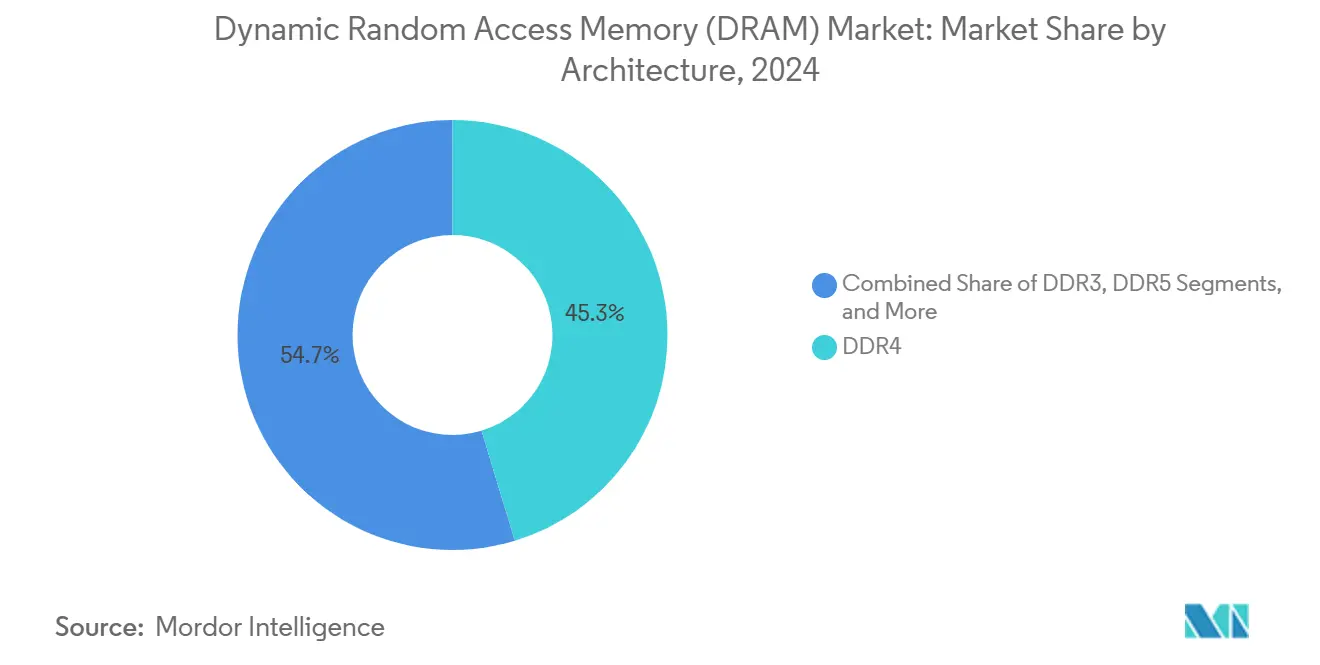
Note: Segment shares of all individual segments available upon report purchase
By Technology Node: Advanced Processes Drive Competitive Differentiation
The 19 nm–10 nm bracket held 42.3% of the Dynamic Random Access Memory market size in 2024 and is projected to grow 25.2% through 2030 as suppliers squeeze additional dies per wafer without plunging into the yield-risk chasm of sub-10 nm. EUV-enabled 1γ production began shipping revenue units in Q1 2025, but line yields remained at least eight points below mature 1z lines. Consequently, many device makers renewed agreements for 1z and 1y grades to buffer cost risk, giving mid-node processes a volume boost.
SK Hynix laid out a vertical-gate DRAM roadmap that promises wafer-level stacking beyond 2027, signalling the long-term pivot from lateral scaling to 3D architectures. Each successive planar shrink delivers less than 12% cost reduction after mask set, materials, and depreciation are factored in, nudging fabs to look for structural redesigns rather than geometrical shrink alone. Cost sensitivity in mobile and consumer electronics kept ≥20 nm nodes alive for price-focused SKUs, ensuring a stratified production mix that diversified fab output and underpinned overall revenue resiliency.
By Capacity: High-Density Configurations Accelerate Across Applications
Modules ≥16 GB are projected to post a 28.2% CAGR and move from niche status in 2024 to mainstream adoption in automotive and premium handsets by 2030. Content per electric vehicle rose from single-digit gigabytes in early 2024 to roughly 40 GB in late 2025 pilot builds, and roadmap discussions among European OEMs reference 4 TB targets for Level-4 autonomy by decade end. Smartphone leaders adopted 16 GB tiers for AI-centric flagship launches in H1 2025, widening the price umbrella for mid-tier 12 GB devices. The 4–8 GB category, while still 41.3% of the Dynamic Random Access Memory market size in 2024, began ceding share as entry-level phones crossed the 6 GB baseline.
Suppliers benefited from richer ASPs on high-density dies but faced wafer-start constraints, especially when balancing HBM3E commitments. Yield learning on 1γ and future 1δ nodes will dictate whether capacity mixes can tilt further upward without triggering undue price shocks. Channel distributors in Shenzhen reported tighter inventory of 8 GB chips during Q2 2025 as fabs prioritized 16 GB die matches to secure data center orders, exemplifying the competition between consumer and enterprise demand vectors.
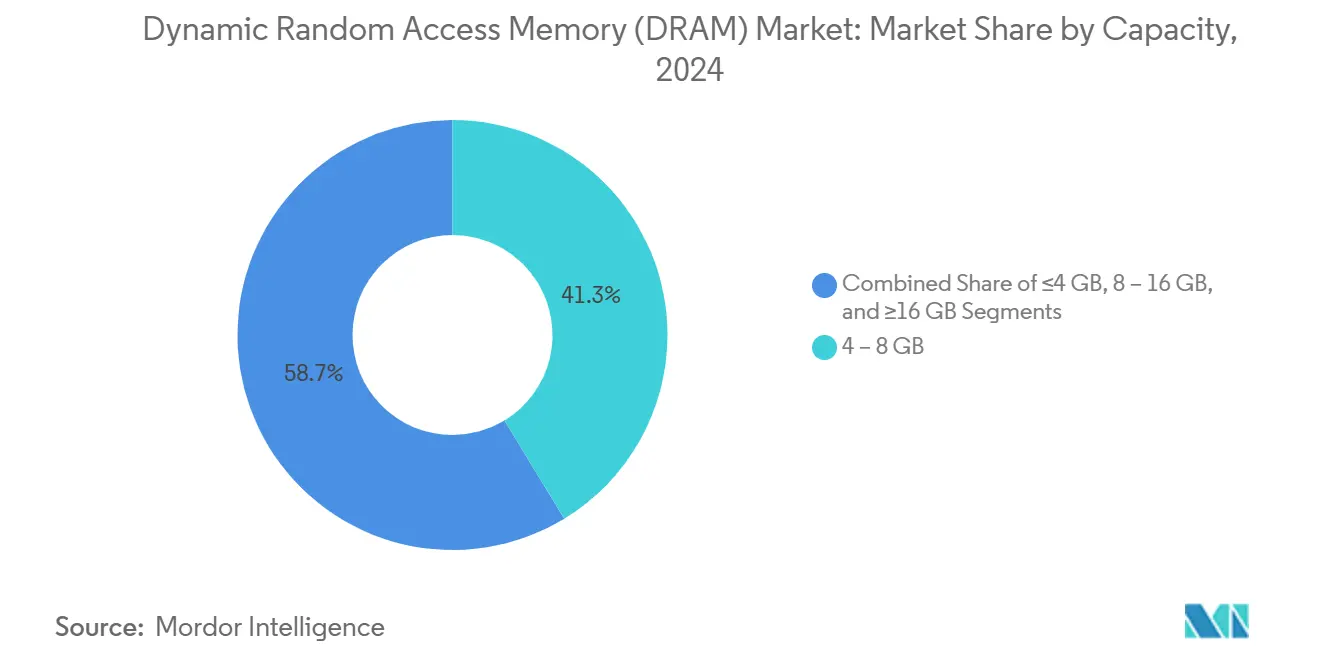
By End-use Application: Automotive Electronics Emerges as Growth Leader
Automotive electronics is forecast to climb at a 31.2% CAGR, eclipsing tablets and PCs as the Dynamic Random Access Memory market’s fastest-moving vertical. Zonal computing architectures mandated high-temperature, high-reliability DRAM that operates over –40 °C to 125 °C, and design wins on 2026 model-year platforms locked in purchase commitments extending beyond 2029. Memory pools approached 90 GB in premium EV prototypes during 2025, equipping vehicles for continuous over-the-air updates and AI-based driver assistance. Smartphone and tablet shipments still delivered a 35.2% revenue share in 2024, but saturation in mature regions tempered their growth trajectory.
Datacenter demand remained robust, driven by AI inference and training clusters whose expansion cycles are now measured in quarters rather than years. Graphics and gaming console refreshes scheduled for late 2026 will provide a cyclical uplift for GDDR and DDR6 variants. Industrial IoT and edge gateways took incremental share by adopting temperature-hardened 8–16 GB modules, though their fragmented nature diluted any single OEM’s bargaining power. The heterogeneous application landscape reinforces supply allocation complexities, compelling vendors to juggle different quality certifications, form factors, and lifecycles in parallel.
Geography Analysis
Asia-Pacific retained a 31.2% revenue position in 2024 on the strength of fabs clustered across South Korea, Taiwan, and mainland China. South Korean suppliers pledged KRW 120 trillion (USD 84 billion) for capacity build-outs through 2028, a figure intended to safeguard leadership in both HBM and traditional DRAM production.[3]SK Hynix, “SEDEX 2024: Showcasing AI Memory Leadership,” news.skhynix.com Taiwan’s contract assembly houses, meanwhile, expanded advanced packaging lines to service rising HBM4 demand, leveraging front-end know-how from logic nodes to introduce Through-Silicon-Via innovations that reduce thermal resistance.
North America formed the largest consumption market as hyperscale builders accelerated rack refreshes and automakers in the United States integrated zonal controllers. Micron secured USD 6.1 billion CHIPS Act funding to construct a new megafab, a move aimed at de-risking geopolitical exposure and shortening lead times for domestic clients. Europe maintained a technology focus on automotive and industrial applications, with German OEMs insisting on extended temperature and longevity guarantees that fetched premium pricing.
South America is forecast to grow at a 22.2% CAGR as Brazil, Argentina, and Mexico nurture electronics assembly ecosystems to localize supply. Policy incentives cut import tariffs on memory components assembled domestically, creating modest but meaningful shifts in sourcing strategies. The Middle East and Africa displayed mid-single-digit growth anchored by data-center build-outs in Gulf Cooperation Council states and rising smartphone penetration in Nigeria and Kenya, yet political instability continued to temper wider adoption. Combined, these regional narratives underscore how the Dynamic Random Access Memory market diversifies revenue streams even as manufacturing remains concentrated in East Asia.
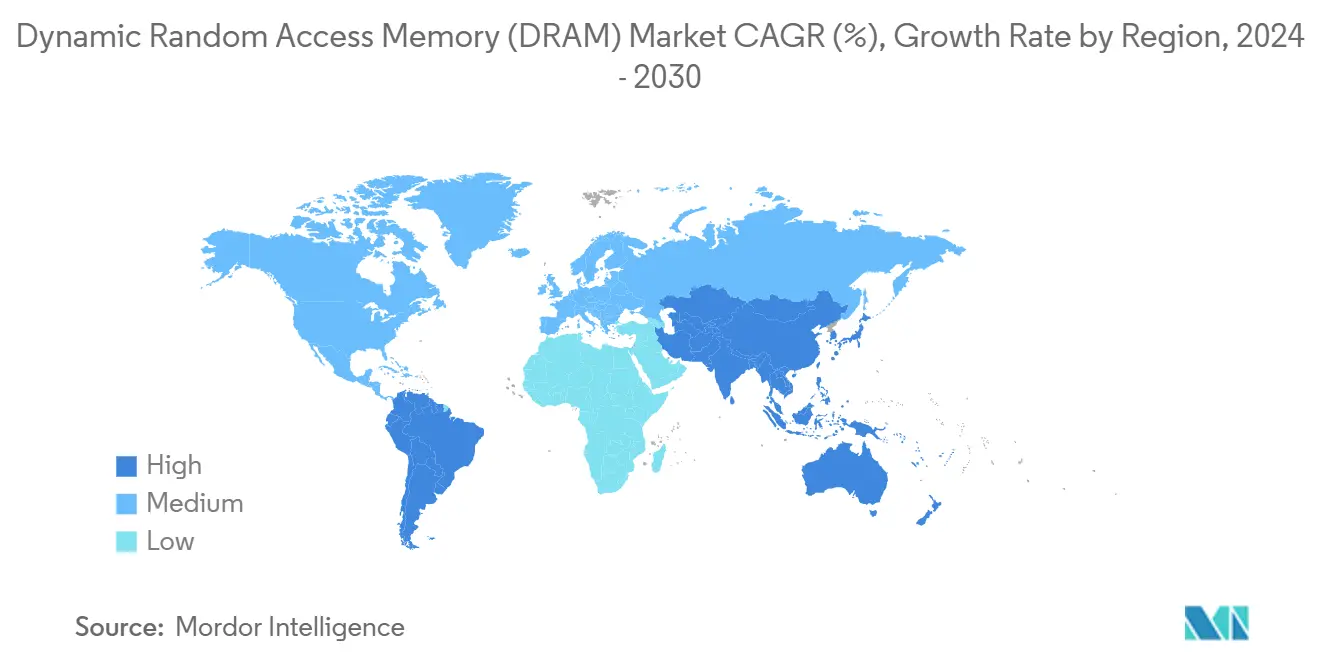
Competitive Landscape
The Dynamic Random Access Memory market operated as an oligopoly in 2025, with Samsung, SK Hynix, and Micron jointly holding roughly 95% of wafer capacity. SK Hynix edged ahead at 36% share in Q1 2025 after being the first to volume-produce 1.15 TB/s HBM3E stacks for leading AI accelerator programs. Samsung retained leadership in automotive-grade lines and secured a USD 3 billion supply agreement with AMD for future HBM3E nodes. Micron closed the technology gap by shipping 1γ DDR5 and LPDDR5X six months ahead of its original roadmap, restoring competitive balance in mainstream DIMM categories.
Technology differentiation revolved around EUV adoption, with every mask layer removed translating into appreciable die cost savings. Yet the steep capital intensity created barriers for second-tier players such as Nanya and Winbond, who chose to specialize in niche industrial or low-power segments rather than chase bleeding-edge nodes. Chinese firms CXMT and JHICC expanded DDR5 output using mature 1x processes, supplying domestic smartphone assemblers that sought to mitigate U.S. export restrictions.
Ecosystem alliances also emerged around interconnect standards like CXL. Marvell partnered with multiple DRAM suppliers to roll out memory expansion controllers that raise attach rates for both DDR4 and DDR5 by pooling resources across server blades. JEDEC’s HBM4 specification, published in April 2025, sparked fresh joint-development agreements between device makers and foundries to align on TSV pitch, thermal budgets, and packaging reliability.[4]JEDEC, “JEDEC Publishes HBM4 Standard,” jedec.org Against this backdrop, startups exploring MRAM, ReRAM, and 3D X-AI aimed for niche workload offloads, though none had yet demonstrated cost parity with commodity DRAM by mid-2025.
Dynamic Random Access Memory (DRAM) Industry Leaders
-
Samsung Electronics Co. Ltd.
-
Micron Technology Inc.
-
SK Hynix Inc.
-
Nanya Technology Corporation
-
Winbond Electronics Corporation
- *Disclaimer: Major Players sorted in no particular order
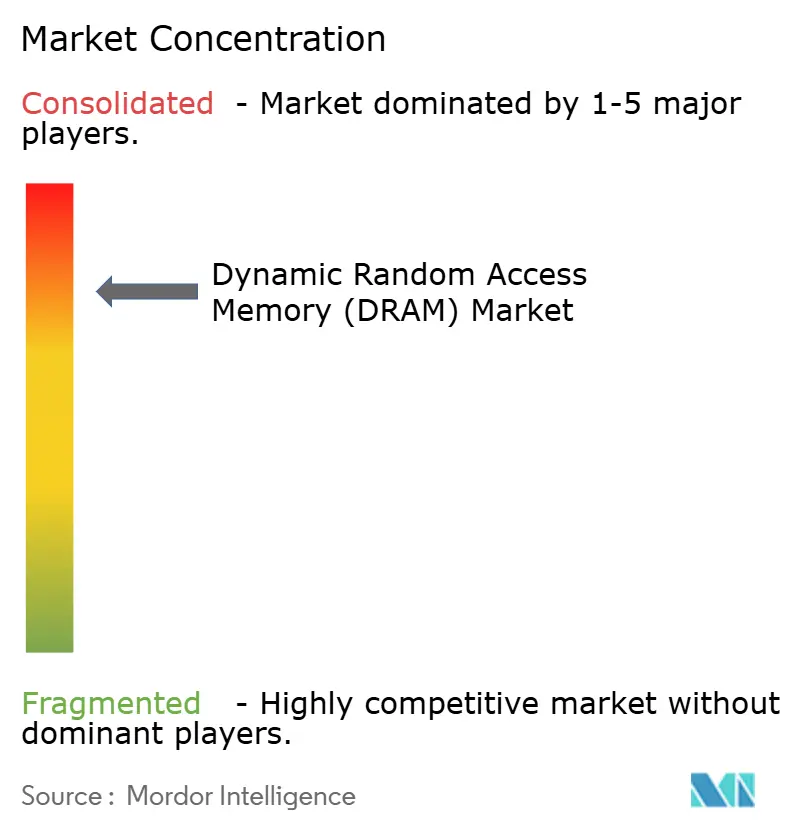
Recent Industry Developments
- April 2025: JEDEC released the HBM4 standard (JESD270-4), doubling channel count to 32 and raising peak bandwidth to 2 TB/s.
- March 2025: SMART Modular introduced a non-volatile CXL memory module in EDSFF form factor for data-intensive servers.
- March 2025: KIOXIA unveiled a 122.88 TB NVMe SSD based on eighth-generation BiCS FLASH, aimed at AI datasets.
- February 2025: Micron Technology announced volume shipment of 1γ DDR5 running at 9,200 MT/s with 20% lower power, marking the first EUV-based sixth-generation DRAM in the market.
Global Dynamic Random Access Memory (DRAM) Market Report Scope
Dynamic random access memory, called DRAM, is used in various computing and electronic devices like PCs, smartphones, music players, laptops, netbooks, and tablet computers. The scope of the study focuses on the market analysis of DRAM semiconductors sold across the globe, and market sizing encompasses the revenue generated through DRAM sold by various market players to end-user industries. The study also tracks the key market parameters, underlying growth influencers, and major vendors operating in the industry, which will support the market estimations and growth rates during the forecast period. The study further analyzes the overall impact of COVID-19 on the ecosystem.
The DRAM market is segmented by architecture (DDR3, DDR4, DDR5, and DDR2), applications (smartphones/tablets, PC/laptops, data centers, graphics, consumer products, and automotive), and geography (the United States, Europe, Korea, China, Taiwan, the Rest of Asia-Pacific, and the Rest of the World). The report offers market forecasts and sizes in value (USD) for all the above segments.
| DDR2 and Earlier |
| DDR3 |
| DDR4 |
| DDR5 |
| LPDDR |
| GDDR |
| ≥20 nm |
| 19 nm – 10 nm |
| <10 nm (EUV) |
| ≤4 GB |
| 4 – 8 GB |
| 8 – 16 GB |
| ≥16 GB |
| Smartphones and Tablets |
| PCs and Laptops |
| Servers and Hyperscale Data Centers |
| Graphics and Gaming Consoles |
| Automotive Electronics |
| Consumer Electronics (Set-top Boxes, Smart TV, VR/AR) |
| Industrial and IoT Devices |
| Others |
| North America | United States | |
| Canada | ||
| Mexico | ||
| Europe | Germany | |
| France | ||
| United Kingdom | ||
| Nordics | ||
| Rest of Europe | ||
| Asia-Pacific | China | |
| Taiwan | ||
| South Korea | ||
| Japan | ||
| India | ||
| Rest of Asia-Pacific | ||
| South America | Brazil | |
| Chile | ||
| Argentina | ||
| Rest of South America | ||
| Middle East and Africa | Middle East | Saudi Arabia |
| United Arab Emirates | ||
| Turkey | ||
| Rest of Middle East | ||
| Africa | South Africa | |
| Rest of Africa | ||
| By Architecture | DDR2 and Earlier | ||
| DDR3 | |||
| DDR4 | |||
| DDR5 | |||
| LPDDR | |||
| GDDR | |||
| By Technology Node | ≥20 nm | ||
| 19 nm – 10 nm | |||
| <10 nm (EUV) | |||
| By Capacity | ≤4 GB | ||
| 4 – 8 GB | |||
| 8 – 16 GB | |||
| ≥16 GB | |||
| By End-use Application | Smartphones and Tablets | ||
| PCs and Laptops | |||
| Servers and Hyperscale Data Centers | |||
| Graphics and Gaming Consoles | |||
| Automotive Electronics | |||
| Consumer Electronics (Set-top Boxes, Smart TV, VR/AR) | |||
| Industrial and IoT Devices | |||
| Others | |||
| By Geography | North America | United States | |
| Canada | |||
| Mexico | |||
| Europe | Germany | ||
| France | |||
| United Kingdom | |||
| Nordics | |||
| Rest of Europe | |||
| Asia-Pacific | China | ||
| Taiwan | |||
| South Korea | |||
| Japan | |||
| India | |||
| Rest of Asia-Pacific | |||
| South America | Brazil | ||
| Chile | |||
| Argentina | |||
| Rest of South America | |||
| Middle East and Africa | Middle East | Saudi Arabia | |
| United Arab Emirates | |||
| Turkey | |||
| Rest of Middle East | |||
| Africa | South Africa | ||
| Rest of Africa | |||
Key Questions Answered in the Report
What is the current value of the Dynamic Random Access Memory market?
The market is valued at USD 108.68 billion in 2025 and is set to reach USD 232.97 billion by 2030.
Which DRAM architecture is growing the fastest?
DDR5 is forecast to rise at a 30.2% CAGR, driven by AI servers and next-generation PCs.
Why are DRAM prices so volatile in 2025?
Fabs diverted capacity to higher-margin HBM3E, leading to a 50% spot-price spike for DDR4 and 15–20% increases for DDR5 in May 2025.
How is the automotive sector influencing DRAM demand?
Software-defined vehicles require high-temperature DRAM, pushing memory content from single-digit gigabytes in 2024 to roughly 90 GB in 2025 prototypes and far higher in future EV platforms.
Which region is expected to grow the quickest through 2030?
South America is projected to expand at a 22.2% CAGR as local assembly incentives attract electronics production.
Who leads the HBM segment today?
SK Hynix moved ahead by being first to fabricate 16-layer HBM3E stacks, securing a 36% share of overall DRAM shipments in Q1 2025.
Page last updated on:
